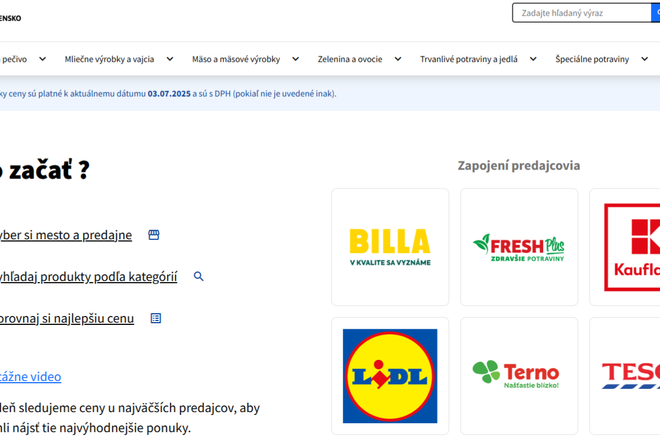Slovakia has launched a new online platform that allows consumers to compare the prices of essential groceries across the country’s leading supermarket chains, in a move aimed at improving transparency and helping households manage the cost of living.
The website, Cenyslovensko.sk, is part of a broader initiative by the Finance Ministry to monitor inflation and was developed following legislation passed late last year. The platform went live on Tuesday in pilot mode and publishes daily price updates for staples such as bread, milk, potatoes and meat.
Six major retailers – Billa, Fresh Plus, Kaufland, Lidl, Terno and Tesco – are participating in the scheme, which excludes smaller chains with lower annual turnover. Prices are refreshed each morning by 6:00 and reflect either the standard or promotional rate available to all customers. Loyalty discounts or member-only offers are not included.
The site’s development cost €150,000, and the ministry has said it plans to enhance its functionality over time to make it more user-friendly. An instructional video is available to guide users through the interface, which also allows comparisons of lactose- and gluten-free products and highlights Slovak-made goods.
Retailers cautious, analysts unconvinced
The government argues the initiative will encourage more disciplined pricing behaviour among retailers. “The goal is to create pressure for fair pricing, especially for essential items,” the ministry said in a statement. The project forms part of Prime Minister Robert Fico’s broader pledge to intervene if food prices rise sharply.
But analysts approached by Denník N are unsure whether consumers will meaningfully engage with the platform. “This might end up being more useful for retailers monitoring their competitors than for households,” said Ľubomír Koršňák, chief economist at UniCredit Bank in Bratislava. “It could streamline market surveillance rather than drive down prices.”
Some in the retail sector also doubt the tool’s practical impact. Martin Krajčovič, head of the Slovak Alliance of Modern Trade, said that while the site offers a snapshot of daily prices, most shoppers will continue to rely on in-store promotions, mobile apps and loyalty programmes. “For a small segment of consumers, this might be a helpful add-on – but it’s not likely to change shopping habits at scale,” he said.
Retail groups have also pointed to the already highly competitive nature of Slovakia’s food sector. Critics say the government effort risks duplicating existing private tools while offering only a narrow range of products – for example, just two types of apples are included under the fruit category.
Inflation slowdown, but pressure persists
The move comes as food price growth in Slovakia continues to ease. According to official data published this week, food inflation slowed to 2.5 percent in 2024, down from more than 15 percent the year before. May figures showed a 2.7 percent year-on-year increase in grocery prices, the slowest rate in the region. One of the reasons is the lower VAT on selected food products.
Still, policymakers remain cautious. The National Bank of Slovakia expects food inflation – including non-alcoholic drinks – to rise to 3.4 percent next year. Officials have also warned that Slovakia remains highly exposed to global commodity price swings, with roughly half of all food and beverages imported.
In this context, the government has also positioned the new platform as a tool to promote domestic producers, with features that allow users to identify Slovak-made alternatives when shopping.
While countries such as Hungary and Greece have rolled out similar price trackers in recent years, their effectiveness remains contested.


